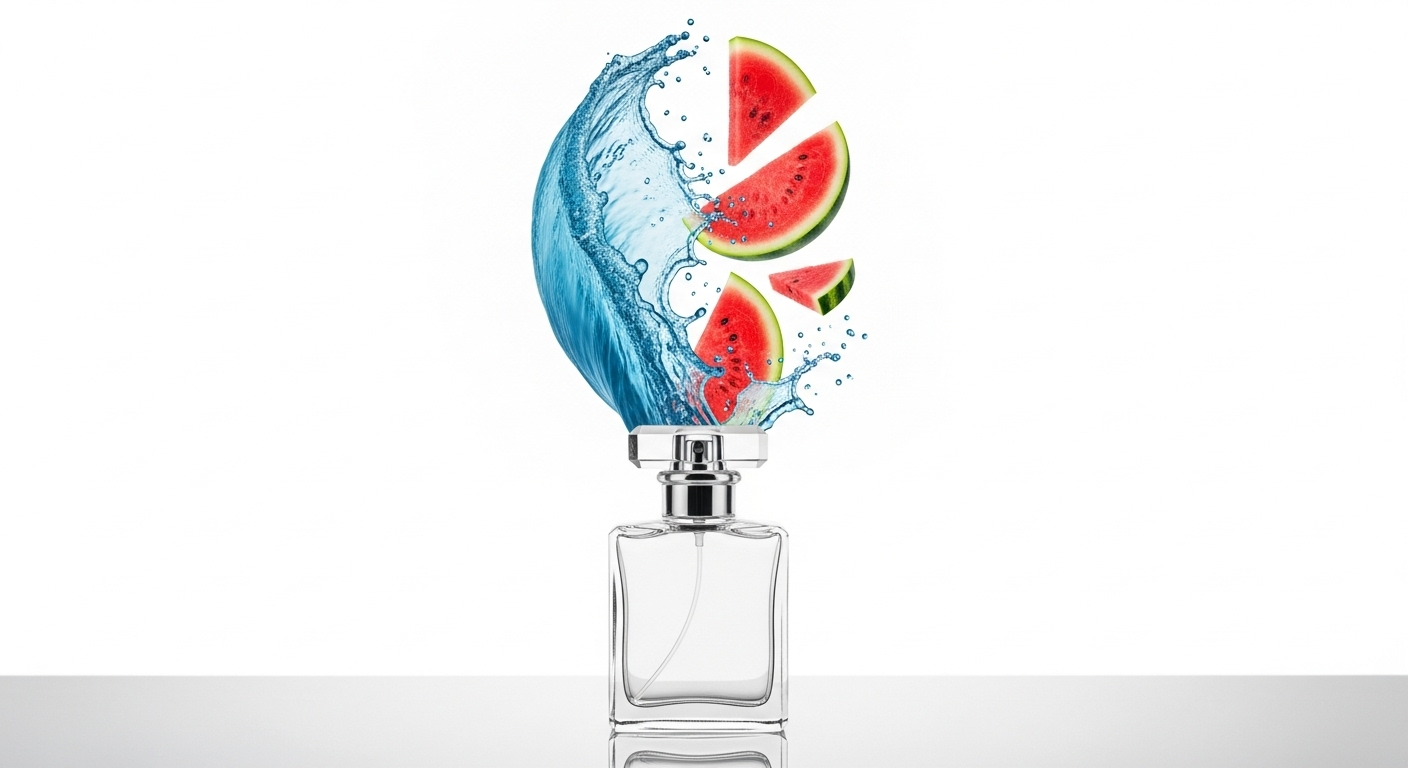In the vast and varied landscape of perfumery, entire fragrance families are often defined by a single, game-changing ingredient. For the “aquatic” or “marine” genre that dominated the 1990s, that ingredient was a synthetic aroma chemical known as Calone 1951. This remarkable molecule, with its distinctive and powerful scent of sea spray, fresh oysters, and watermelon rind, was a complete departure from the heavy, spicy orientals and rich florals of the preceding decades, single-handedly ushering in an era of clean, fresh, and ozonic fragrances.
Discovered by Pfizer chemists in 1966, Calone remained a relatively obscure captive molecule for years before its explosive debut in fragrances like Davidoff’s Cool Water (1988) and L’Eau d’Issey (1992). Its unique profile gave perfumers an entirely new tool to evoke the feeling of open water and ocean air, a feat that had been impossible to achieve with traditional natural extracts. Understanding the origin and impact of this single molecule is essential for appreciating the evolution of modern perfumery.
The story of Calone is a lesson in how a single, well-deployed innovation can create an entirely new aesthetic category. This principle of foundational ingredients is just as relevant in the tangible world of home maintenance and care. For instance, the long-term health of any collection, be it art or perfume, hinges on understanding how to prevent degradation from temperature changes, a form of maintenance that protects the core integrity of the items.
The Scent Profile of the Sea
The chemical name for Calone is Methylbenzodioxepinone, but its evocative power lies in its unique and unmistakable scent profile. It does not smell like a single object, but rather a complex collection of impressions that our brains strongly associate with the seaside. The primary descriptors for its aroma are “marine,” “ozonic,” and “watery,” but it also possesses distinct fruity undertones, most notably of fresh watermelon.
This complex character is what makes Calone so versatile and impactful. It provides a powerful marine and ozonic impression that can transport the wearer to a windswept beach with a single sniff. It is a clean, bright, and diffusive scent that feels both natural and entirely novel, a perfect olfactory representation of a cool ocean breeze.
This scent was revolutionary because it was not an interpretation of the sea; it felt like the sea itself. It allowed perfumers to move beyond simple citrus or herbal notes to create a genuine feeling of aquatic freshness. This new tool opened the door to a minimalist, transparent style of perfumery that defined an entire decade.
A Chemical Accident, An Artistic Triumph
The discovery of Calone was, like many great scientific breakthroughs, a complete accident. Chemists at Pfizer were not searching for a new perfume ingredient; they were working on developing a new tranquilizer. During their research into benzodiazepines, they synthesized the Methylbenzodioxepinone molecule and, as part of their standard safety testing, noted its incredibly powerful and unique aroma.
Recognizing its potential in the fragrance industry, Pfizer patented the molecule under the trade name Calone 1951. For nearly two decades, it remained a captive molecule, used internally and in functional products like soaps and detergents.
- 1966: The molecule is first synthesized and its unique scent is noted by Pfizer chemists.
- 1970s: It is used sparingly as a captive molecule in functional fragrances to add a “fresh” note.
- 1988: Perfumer Pierre Bourdon uses a significant dose of Calone in Davidoff’s Cool Water, creating the first mainstream masculine aquatic fragrance.
- 1992: Jacques Cavallier uses an even larger dose in Issey Miyake’s L’Eau d’Issey, cementing the aquatic trend and making Calone a household name in perfumery.
This journey from a pharmaceutical lab to a blockbuster perfume is a testament to the power of serendipity and the ability of a creative artist to see the potential in a novel material.
The Rise and Fall of a Trend
The success of fragrances like Cool Water and L’Eau d’Issey triggered a veritable tidal wave of aquatic scents throughout the 1990s. Calone became one of the most widely used ingredients in the industry, as brands rushed to capitalize on the public’s newfound love for clean, marine aromas. This period saw the launch of countless “blue” fragrances, all built around a prominent Calone accord.
However, this ubiquity eventually led to the molecule’s downfall. As with any trend that becomes oversaturated, consumers began to experience “Calone fatigue.” The scent, once so novel and exciting, started to feel dated and generic. Its distinctive watermelon-oyster note became instantly recognizable and was often associated with the cheap body sprays and air fresheners that had adopted it.
By the early 2000s, perfumers began to move away from heavy-handed use of Calone, seeking new ways to evoke a sense of freshness. The industry shifted towards more subtle mineralic notes, green accords, and “salt-skin” effects. While Calone is still used today, it is typically in much smaller, more nuanced doses, as a supporting player rather than the star of the show.
The Legacy of Calone 1951
Despite the backlash against the 90s aquatic trend, the importance of Calone in the history of perfumery cannot be overstated. It was a truly groundbreaking molecule that fundamentally changed the perfumer’s palette and introduced a new, abstract style of fragrance composition. It proved that a single synthetic molecule could define an entire genre and capture the imagination of a generation.
The legacy of Calone is not just in the specific scents it created, but in the creative doors it opened. It inspired a new wave of research into synthetic marine and ozonic aroma chemicals, leading to the development of a whole new class of ingredients. Modern perfumers now have a vast array of tools to create a sense of water, from the salty, mineralic scent of seaweed absolute to the airy transparency of molecules like Transluzone.
Calone taught the industry that a fragrance could be about a feeling or an environment, not just a collection of flowers or spices. It paved the way for the minimalist, conceptual, and abstract styles of perfumery that are popular today. It was the catalyst for modern freshness, and its influence can still be felt in the DNA of countless contemporary scents.
Frequently Asked Questions
No, there is no natural extract that can replicate the specific scent profile of Calone. While some materials, like seaweed absolute or certain types of algae, have a “marine” quality, they do not possess the unique combination of ozonic, watery, and fruity notes that defines Calone. It is a truly synthetic creation.
The “Calone” part of the name is derived from the fact that it is a ketone, a type of organic compound. The “1951” is simply an internal project or reference number assigned to the molecule by the chemists at Pfizer.
Yes, but much more sparingly and artfully than in the 1990s. A modern perfumer might use a tiny trace of Calone to add a watery “dewy” effect to a floral composition or to provide a subtle “salty air” lift to a woody fragrance. It is now used as a nuanced accent rather than the dominant, central theme.

